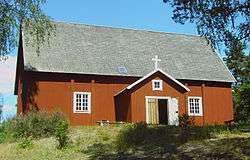Loppi
Loppi (Swedish: Loppi, also Loppis) is a municipality in Finland. It is located in the province of Southern Finland and is part of the Tavastia Proper region. Loppi was founded in 1632. The municipality has a population of 7,865 (31 January 2019)[6] and covers an area of 655.97 square kilometres (253.27 sq mi) of which 58.36 km2 (22.53 sq mi) is water.[1] The population density is 13.16 inhabitants per square kilometre (34.1/sq mi). The municipality is unilingually Finnish. Neighbour municipalities are Hyvinkää, Hämeenlinna, Janakkala, Karkkila, Riihimäki, Tammela and Vihti. The most significant main road connection to get from Loppi to Riihimäki is the national road 54, which runs between Tammela and Hollola.
Loppi | |
|---|---|
Municipality | |
| Lopen kunta Loppi kommun | |
 Saint Bridget Church | |
 Coat of arms | |
 Location of Loppi in Finland | |
| Coordinates: 60°43′N 024°26.5′E | |
| Country | |
| Region | Tavastia Proper |
| Sub-region | Riihimäki sub-region |
| Founded | 1632 |
| Government | |
| • Municipal manager | Mikko Salmela |
| Area (2018-01-01)[1] | |
| • Total | 655.97 km2 (253.27 sq mi) |
| • Land | 597.62 km2 (230.74 sq mi) |
| • Water | 58.36 km2 (22.53 sq mi) |
| Area rank | 140th largest in Finland |
| Population (2019-01-31)[2] | |
| • Total | 7,865 |
| • Rank | 125th largest in Finland |
| • Density | 13.16/km2 (34.1/sq mi) |
| Population by native language | |
| • Finnish | 98.3% (official) |
| • Swedish | 0.4% |
| • Others | 1.2% |
| Population by age | |
| • 0 to 14 | 19.8% |
| • 15 to 64 | 62.4% |
| • 65 or older | 17.7% |
| Time zone | UTC+02:00 (EET) |
| • Summer (DST) | UTC+03:00 (EEST) |
| Municipal tax rate[5] | 20% |
| Website | www.loppi.fi |
The subject of the municipal coat of arms, where the iron symbol has sunk into a wave-cut plate, refers to the lifting of limonite from the lake in the early period.
According to local folklore, Kaakkomäki of Loppi was inhabited by a giant devil in ancient times. When Loppi’s old church, Saint Bridget Church, was built in the 17th century, the devil tried to disrupt the construction and became enraged when the church bells rang. The devil tried to destroy the church bell tower and threw it with a large rock. However, the rock flew over the church to Tiirinkallio on the shore of Lake Loppijärvi, from where the rock was combed into the lake. The stone in the lake brought a disaster: cattle fell ill and animals died. So the villagers crammed the rock up the cliff and the luck of the cattle was restored.[7]
Loppi is especially known for its potato cultivation,[8] and the potato is classified as the municipality's title plant.[9]
Villages
There are three big villages in the municipality: Loppi (Kirkonkylä), Launonen and Läyliäinen. Most of the inhabitants of the municipality live in these villages, as they are located along the significant main road connections of the municipality.
Other (smaller) villages are Hevosoja, Hirvijärvi, Hunsala, Joentaka, Kormu, Metsäkylä, Ourajoki, Pilpala, Räyskälä, Sajaniemi, Salo, Teväntö, Topeno and Vojakkala.
Attractions
Marshal Mannerheim's hunting lodge (Marskin maja (Marshal's lodge) in Finnish) was moved from Karelia to Loppi in 1942 during the Continuation War. It is located on the side of lake Punelia and nowadays functions as a restaurant and museum.
The Räyskälä Airfield is located in Loppi. It is home to the Finnish Sports Aviation Academy and one of the busiest general aviation airfields in Finland.
The church of Saint Birgitta is situated in Loppi. It is commonly called the Santa Pirjo, Pirjo being the Finnish version of the name Birgitta. The church is one of the oldest wooden churches in Finland, being about 300 years old.
Notable people
- Julius Ailio (1872–1933), an archaeologist and politician
- Timo Jurkka (born 1963), an actor
- Mikko Lahtio (born 1984), a middle-distance runner
- Sami Lähteenmäki (born 1989), an ice hockey player
- Heikki Mikkola (born 1945), a motocross racer
- Otto Paajanen (born 1992), an ice hockey player
- Kalle Sievänen (1911–1996), a sport shooter
References
- "Area of Finnish Municipalities 1.1.2018" (PDF). National Land Survey of Finland. Retrieved 30 January 2018.
- "Suomen virallinen tilasto (SVT): Väestön ennakkotilasto [verkkojulkaisu]. Tammikuu 2019" (in Finnish). Statistics Finland. Retrieved 15 March 2019.
- "Population according to language and the number of foreigners and land area km2 by area as of 31 December 2008". Statistics Finland's PX-Web databases. Statistics Finland. Retrieved 29 March 2009.
- "Population according to age and gender by area as of 31 December 2008". Statistics Finland's PX-Web databases. Statistics Finland. Retrieved 28 April 2009.
- "List of municipal and parish tax rates in 2011". Tax Administration of Finland. 29 November 2010. Retrieved 13 March 2011.
- "Population by municipality as of 31 December 2008". Population Information System (in Finnish and Swedish). Population Register Center of Finland. Archived from the original on 2010-12-02. Retrieved 2 May 2010.
- Loppilainen taru (in Finnish)
- Loppi tunnetaan perunasta - tulevaisuudessa mahdollisesti myös harvinaisesta perhoslajista? (in Finnish)
- Lopen nimikkolajit (in Finnish)
External links
![]()
- Municipality of Loppi – Official website
- Finnish Sports Aviation Academy (in Finnish)
- Räyskälä Airfield
- Hyrinet – Hyvinkää–Riihimäki area portal (in Finnish)
